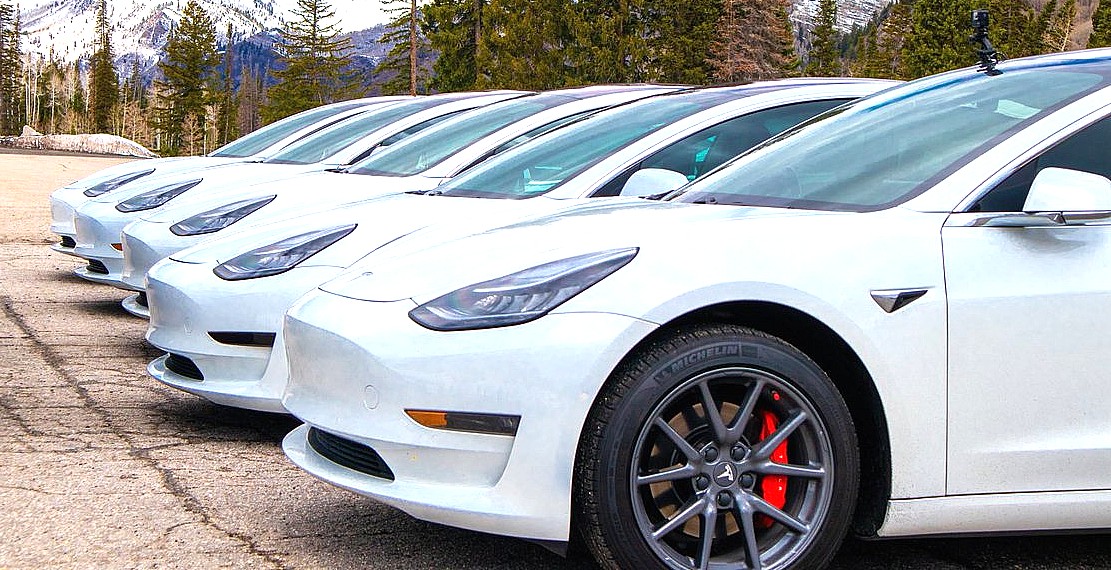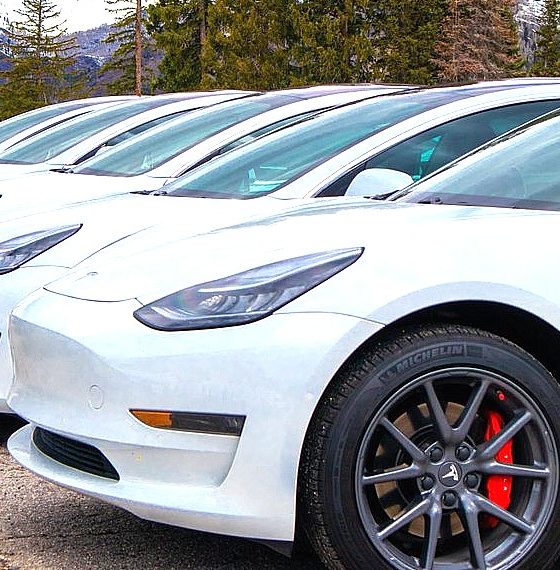

Lifestyle
Tesla’s competitors aren’t perfect, but they could help usher in a new EV crowd
Welcome to a FREE preview of our weekly exclusive! Each week our team goes ‘Beyond the News’ and handcrafts a special edition that includes our thoughts on the biggest stories, why it matters, and how it could impact the future.
You can receive this newsletter along with all of our other members-exclusive newsletters, become a premium member for just $3/month. Your support goes a long way for us behind the scenes! Thank you.
—
Taking Tesla head-on as a car maker these days certainly appears to be a formidable task, but perhaps it’s not sacrilege to applaud the various efforts along the way. Elon Musk has mentioned how the California brand can’t achieve its sustainability mission alone on several occasions, as most Tesla fans are aware, but the big picture is not just about pure numbers of electric vehicle (EV) players. It’s also about consumer taste and finances.
For one, big cars are pretty popular in Tesla’s home market, the United States. Sure, Tesla has the Model X for anyone looking for an SUV. But in some parts of the US, it’s on par with the price of a home mortgage and out of financial reach for many (most?) larger families. I actually tried promoting the idea of a Tesla to my best friend who happens to be a lawyer and whose partner has a well-paying IT job; they sounded like the ideal income bracket for the brand’s larger offering to me. Her immediate response was, “Ha! We could never afford a Tesla!” We spoke about the Model 3 and upcoming Model Y, but with 3 kids in day care (and all with large car seats), she couldn’t take on ‘another mortgage’ just to drive them from place to place regardless of the other advantages.
By the way, I’m sure Tesla will address this consumer gap eventually, but for now I’m making a point about their competitors finding a market niche that could be a boon for Tesla in the long run.
Audi could potentially have another all-electric option for someone like my friend in the e-tron. The $70,000+ price tag doesn’t quite compare to the $30,000 or so she paid for her Honda Pilot, but if you lined up gas and maintenance costs AND presented the e-tron 50, my bargain-loving bestie might bite. Audi recently launched this 71 kWh, shorter-range version of the larger e-tron SUV in Norway, and it runs about $55,000 with somewhere around 150 miles of range. As her kids get older (and car seats become smaller boosters), she might get used to the whole ‘just plug your car in at night’ perk and be open to something a little more entertaining a la Tesla.
Then there’s the Jaguar I-PACE. Despite its troubles with range estimates and charge point access, this all-electric luxury brand crossover does have one advantage over Tesla to some consumers: It’s not a Tesla. Now, I don’t mean that in a derogatory way. I’m more so saying that there are plenty of consumers that are used to admiring the style of certain brands and grew up dreaming of owning one some day. My co-worker’s husband comes to mind, actually.
While he thinks Tesla has some amazing performance stats, he’s a ‘hot hatch’ kind of guy. He simply likes the style of the I-PACE a bit more than a Tesla right now, and would also prefer his first EV to come from a brand whose other models have caught his attention for decades. If he were to take up his old pastime of hobby racing using the I-PACE though, which would certainly be tempting after experiencing the immediate torque and horsepower from an EV, he’d probably see the light surrounding Tesla ownership after being smoked by a few Model 3 Performances.
Finally, there are the budget buyers (myself included) who see the $35,000-ish Model 3, but then also see the $15,000 used Nissan LEAF. Since I have a few kids, this purchase would be purely an ‘errand runner’ as my main car needs to be larger and not cost more than my future land and farmhouse combined. If the price of a used Tesla comes down to that sort of bargain, which is unlikely given the Tesla Network plans for the Model 3, I would certainly bite. But the LEAF does something useful: It gets people like me into an electric car that I can afford, which is part of the big picture isn’t it? And kids do grow up and buy their own cars eventually, meaning I can one day trade in my mini van for something a little more…Tesla.

Lifestyle
Tesla Model S Plaid battles China’s 1500 hp monster Nurburgring monster, with surprising results
There is just something about Tesla’s tuning and refinement that makes raw specs seem not as game-changing.

The Tesla Model S Plaid has been around for some time. Today, it is no longer the world’s quickest four-door electric sedan, nor is it the most powerful. As per a recent video from motoring YouTube channel Carwow, however, it seems like the Model S Plaid is still more than a match for some of its newer and more powerful rivals.
The monster from China
The Xiaomi SU7 Ultra is nothing short of a monster. Just like the Model S Plaid, it features three motors. It also has 1,548 hp and 1,770 Nm of torque. It’s All Wheel Drive and weighs a hefty 2,360 kg. The vehicle, which costs just about the equivalent of £55,000, has been recorded setting an insane 7:04.957 at the Nurburgring, surpassing the previous record held by the Porsche Taycan Turbo GT.
For all intents and purposes, the Model S Plaid looked outgunned in Carwow’s test. The Model S Plaid is no slouch with its three motors that produce 1,020 hp and 1,420 Nm of torque. It’s also a bit lighter at 2,190 kg despite its larger size. However, as the Carwow host pointed out, the Model S Plaid holds a 7:25.231 record in the Nurburgring. Compared to the Xiaomi SU7 Ultra’s record, the Model S Plaid’s lap time is notably slower.
Real-world tests
As could be seen in Carwow’s drag races, however, Tesla’s tech wizardry with the Model S Plaid is still hard to beat. The two vehicles competed in nine races, and the older Model S Plaid actually beat its newer, more powerful counterpart from China several times. At one point in the race, the Xiaomi SU7 Ultra hit its power limit due to its battery’s temperature, but the Model S Plaid was still going strong.
The Model S Plaid was first teased five years ago, in September 2020 during Tesla’s Battery Day. Since then, cars like the Lucid Air Sapphire and the Xiaomi SU7 Ultra have been released, surpassing its specs. But just like the Model Y ended up being the better all-rounder compared to the BYD Sealion 7 and the MG IM6, there is just something about Tesla’s tuning and refinement that makes raw specs seem not as game-changing.
Check out Carwow’s Model S Plaid vs Xiaomi SU7 drag race video below.
Lifestyle
500-mile test proves why Tesla Model Y still humiliates rivals in Europe
On paper, the BYD Sealion 7 and MG IM6 promised standout capabilities against the Model Y.

BYD is seeing a lot of momentum in Europe, so much so that mainstream media has taken every opportunity to argue that the Chinese automaker has beaten Tesla in the region. But while BYD sales this year in Europe are rising and Tesla’s registrations remain challenged, the raw capabilities of vehicles like the Model Y are difficult to deny.
This was highlighted in a 500-mile challenge by What Car? magazine, which showed that the new Tesla Model Y is more efficient, cheaper to run, and more reliable than rivals like the BYD Sealion 7, and even the nearly 400 KW-charging MG IM6.
Range and charging promises
On paper, the BYD Sealion 7 and MG IM6 promised standout capabilities against the Model Y. The Sealion 7 had more estimated range and the IM6 promised significantly faster charging. When faced with real-world conditions, however, it was still the Model Y that proved superior.
During the 500-mile test, the BYD nearly failed to reach a charging stop, arriving with less range than its display projected, as noted in a CarUp report. MG fared better, but its charging speeds never reached its promised nearly-400 kW charging speed. Tesla’s Model Y, by comparison, managed energy calculations precisely and arrived at each stop without issue.
Tesla leads in areas that matter
Charging times from 25% to 80% showed that the MG was the fastest at 17 minutes, while Tesla and BYD were close at 28 and 29 minutes, respectively. Overall efficiency and cost told a different story, however. The Model Y consumed 19.4 kWh per 100 km, compared to 22.2 for MG and 23.9 for BYD. Over the full trip, Tesla’s charging costs totaled just £82 thanks to its supercharger network, far below BYD’s £130 and MG’s £119.
What Car? Magazine’s testers concluded that despite BYD’s rapid sales growth and the MG IM6’s seriously impressive charging speeds, Tesla remains the more compelling real-world choice. The Model Y just offers stability, efficiency, and a proven charging infrastructure through its Supercharging network. And as per the magazine’s hosts, the Model Y is even the cheapest car to own among the three that were tested.
Watch What Car? Magazine’s 500-mile test in the video below.
Lifestyle
Tesla Cybertruck slapped with world’s least intimidating ticket, and it’s pure cringe
One cannot help but cringe and feel second-hand embarrassment at the idea of a person just driving around with a stack of these babies.

A Cybertruck parked at Stanford Shopping Center in California was recently hit with what might be the most try-hard piece of paper ever slipped under a wiper blade: a “fake citation” accusing the driver of supporting a “fascist car.”
The note, shared on X by Tesla staff program manager Ryan Torres, quickly made the rounds on X, where it quickly gained attention as an example of how not to protest.
The world’s least intimidating ticket
According to the citation, the supposed “violation” was “driving a fascist car.” The remedial action? Take the bus, call an Uber, or ride a bike. The note also dubbed Elon Musk a “chainsaw-wielding Nazi billionaire.” Now, protests against Tesla and Elon Musk have become commonplace this year, but one cannot help but cringe and feel second-hand embarrassment at the idea of a person just driving around with a stack of fake anti-Tesla/Musk citations.
Torres pointed out the irony himself in his post on X. Tesla currently employs over 140,000 Americans, and SpaceX has put the U.S. firmly back at the top of space technology. As Torres put it, maybe the person behind the world’s least intimidating ticket should “read a book on innovation before vandalizing” other people’s property.
Peak performative clownery
Not to mention that the fake ticket’s logic collapses under its own weight. EVs like the Cybertruck are literally designed to reduce emissions, not “destroy the economy.” If anything, Tesla has bolstered the United States’ economy by fueling jobs in engineering, manufacturing, and clean energy. It’s not the first time a Tesla has been the target of vandalism or politically charged notes, but this one stands out for sheer cringe value.
Torres summed it up neatly: “Peak clownery.” On that point, at least, the citation earns full marks. In a way, though, perhaps cringe fake tickets are not as bad as the literal firebombs that were being thrown at Tesla stores and cars earlier this year because some critics were gleefully misinformed about Elon Musk.








